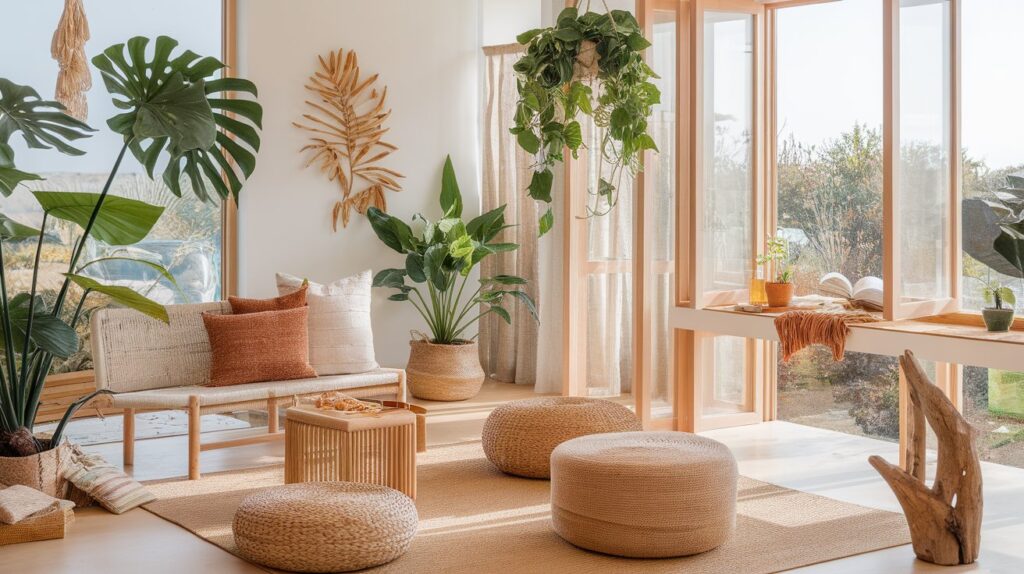Nature has a naturally soothing quality; its textures, colors, and organic beauty speak to our need for peace and balance. More and more homeowners are seeking to include that grounding, natural element into their living areas in a fast-paced world dominated by technology and synthetic surroundings.
Adding a natural element to your house improves not only its visual appeal but also promotes wellness and peace, whether your residence is a large rural timber house or a busy city apartment.
This post will show how little, deliberate design decisions might bring life to your house, accentuate the natural beauty of rustic materials, and produce a lively and welcoming environment. We will also go further for the green thumbs and garden enthusiasts by talking on how you might create a lovely natural nook-a personal refuge for leisure, inspiration, and maybe even home-grown food.
Little Notes, Great Influence: Bringing Life into Your Home
Incorporating natural elements does not always mean a full house renovation. Sometimes the smallest elements count most in difference.
- Add to your decor textures and elements including rattan, jute, wicker, bamboo, and reclaimed wood from Natural Materials These materials accentuate almost any kind of design and have a warm, earthy feel. Think of woven baskets, wooden trays, linen throws, or seagrass rugs-each item quietly reminds me of the great outdoors.
- Bring in Houseplants:Few things accentuate a space more than foliage. Along with providing a flash of color, houseplants including pothos, fiddle leaf figs, snake plants, and peace lilies clean the air and improve mood. Arrange a few plants of different heights in one corner or line your shelves with trailing vines to create a rich, jungle-like impression.
- Think of a natural color palette-that of forest greens, sandy beiges, clay reds, and ocean blues. Earthy colors These tones naturally calm you and foster a link between your house and the outside natural world.
- Try to maximize your natural light wherever you can. Keep window treatments light or sheer, then reflect sunlight deeper into your house with mirrors. Natural light gives a space more life rather than merely makes it seem larger.
- Choose furniture or decor items with flowing, curved lines instead of sharp, geometric forms. This produces a more laid-back, harmonic environment and reflects the natural, organic, flawed lines found in nature.
Improving a Timber Home’s Rustic Appeal
If you happen to live in a timber house, you are already halfway towards embracing nature. Warm ambiance, great character, and raw, natural beauty abound in timber homes. Even these earthy retreats, though, can profit from a few careful additions that accentuate their inherent qualities.
- Let the grain of the wood tell for itself. Let wooden beams or paneling shine in their natural or stained form instead of painting or wallcovering over them. Your house gains authenticity and depth from the grain patterns, which also tell a tale of time and expansion.
- Rustic homes really shine on texture. Match a soft, woven rug with a rough-hewn wooden coffee table or mix leather chairs with wool blankets. These combinations create visual appeal and help your room to seem comfortable and inviting.
- Think about including wall art or sculptures reflecting the outdoors-perhaps forest scenes, animal themes, or pressed botanical prints. These give personality and character while supporting the inherent theme.
- Make use of recycled and used materials; rustic style and sustainability go hand in hand. For shelves or tables, use recycled wood; search for vintage or second-hand items with personal histories. These features help a timber house to be timeless and authentic.
The Pleasure of a Nature Nook: A Paradise for Green Thumbs
As we discuss natural beauty, let’s go one step further-why not design a nature nook right in your house? Whether through gardening, plant care, or just lounging among your preferred plants, a nature nook is a small, designated space meant for connecting with greenery. For those who enjoy gardening or anyone else hoping to produce their own herbs, vegetables, or even sweet-smelling flowers, this is particularly fulfilling.
- A nature nook requires little space-just a sunny windowsill, a balcony corner, or even a recycled portion of your kitchen. The secret is good air flow and natural light.
- Plan your greenery based on your objectives: small vegetables like cherry tomatoes and lettuce or aromatic herbs like basil, thyme, and rosemary. Choose flowering plants like lavender, jasmine, or gardenia to cover your nook with pleasing smells if food isn’t your main concern.
- Add cozy seating to your nature nook so you might hang about there. Add a floor cushion or comfortable chair, some soft lighting for evenings, and perhaps even a little table for your tea or journal. The intention is to design a quiet haven right inside your house.
- To maximize vertical space, use hanging pots, wall-mounted planters, or tiered plant stands and stay orderly using vertical storage. This keeps your nook aesthetically pleasing and orderly, particularly in cases of a small workspace.
- Add personal touches to make the space especially yours: hand-painted pots, inspirational sayings, family heirlooms in line with the garden theme. These little details give your nature nook soulful rather than merely utilitarian quality.
Final Thoughts
Including a natural element into your house is a way of life choice rather than only a design one. It’s about rediscovering our roots, respecting natural beauty, and planning a space that feeds the body and the psyche.
Whether you’re including earthy accents into your urban apartment, valuing the raw elegance of your timber house, or design a quiet nature nook in a sunny corner, the delight of nature can be found-and felt-inside your own walls.
After opening the windows and letting in the breeze, then bring the outside inside. A few small changes will enable your house to become a vibrant, living refuge mirroring the beauty and balance of the world beyond your door.

